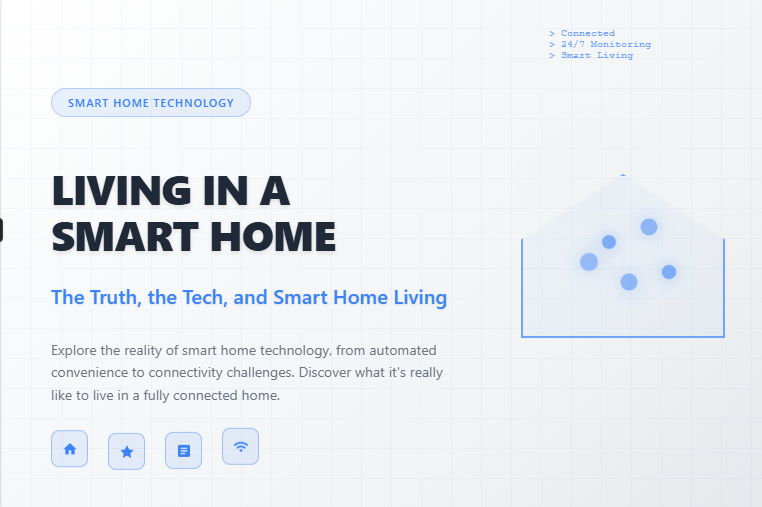Smart Home Living 2025
It’s 3 a.m., and my living room lights are throwing an unscheduled disco party while Alexa lectures my cat about personal boundaries.
Welcome to my smart home living — a mix of futuristic magic, occasional chaos, and the occasional existential debate with my toaster.
By 2025, smart home and IoT technology will have gone from luxury novelties to everyday household staples. But here’s the truth: behind the glossy brochures and Instagram-ready setups are quirks, surprises, and the occasional “Why did my fridge just send me a notification?” moments.
This is my honest, unfiltered, slightly sarcastic take on living in a smart home — the good, the bad, and the weird.
The Reality of Smart Home Living
When I first jumped in, I imagined:
The lights greeting me with a gentle glow in the morning
A thermostat that predicted my every mood
Coffee brewing itself before I got out of bed
The marketing promised seamless convenience. The reality? Let’s just say my kitchen lights and I have trust issues.
I set them to turn on at 5:30 a.m. — but sometimes they decide 4:45 a.m. is “close enough.” Who’s really in control here, me or my Wi-Fi-connected lightbulbs?
Popular Smart Home Living Picks in 2025:
Philips Hue – Still the gold standard for customizable lighting
LIFX Bulbs – Bright colors, but occasionally moody (like my cat)
Govee Glide Panels – Great for wall art meets lighting
Smart Home Security: Comfort or Creepy?
When I installed my first Ring Doorbell, I thought, Finally, peace of mind.
What I didn’t expect was my house becoming the star of its own low-budget sci-fi thriller.
Now my setup includes:
Arlo Ultra 2 Cameras – Crystal-clear 4K footage (great for seeing every squirrel in the yard)
Eufy Security – No subscription fees, but sometimes overreacts to shadows
Nest Doorbell (Battery) – Facial recognition so good it greets my delivery driver by name
Quirks:
Facial recognition can be too good. My doorbell now knows the neighbor’s cat schedule better than I do.
Halloween 2024: My smart camera mistook an inflatable ghost for an intruder and set off the whole system — lights flashing, sirens blaring, me apologizing to three blocks of neighbors.
Smart Home Energy: Saving the Planet (and My Sanity)
The smart home market is projected to hit $633 billion by 2032, and a big part of that is energy efficiency. But… are these devices really saving energy, or just giving us more firmware updates?
Energy-Saving All-Stars:
Nest Learning Thermostat – Knows your schedule, sometimes too well
Ecobee SmartThermostat – Built-in Alexa, but loves to “help” at odd times
Kasa Smart Plugs – Cheap, reliable, great for automating anything
I’ve cut my energy use by about 20% — but there’s a trade-off. My thermostat once decided “eco-friendly” meant keeping my living room at 62°F in July.
Pros & Cons of Smart Home Living in 2025
Pros and Cons
Convenience – control everything from your phone Devices sometimes have a mind of their own
Increased security with cameras and alerts Privacy concerns with always-on microphones
Energy savings with smart thermostats & lighting Over-reliance on Wi-Fi
Fun factor (custom lighting, automation) Occasional tech glitches lead to frustration
Wild Card: Are Smart Homes Becoming… Self-Aware?
Some nights, I wonder: what if my AI-powered fridge refuses to open if it detects I’m reaching for ice cream after 10 PM?
It’s funny — but also, with AI, blockchain, and VR all merging into home tech, it’s not that far-fetched.
Future trends include:
Voice assistants that adapt to your mood
Appliances that talk to each other (fridge tells the oven what’s for dinner)
Health monitoring via your home (lights that detect when you’ve been sitting too long)
Bottom Line: Should You Go Smart in 2025?
Living in a smart home is like having a roommate that’s helpful, unpredictable, and occasionally nosy.
If you value convenience, security, and a touch of futuristic fun — it’s worth it.
Just be prepared for the occasional 3 a.m. light show and a fridge that thinks it’s your diet coach.
Pro Tip: Start small. Pick one area (security, lighting, or energy) and build from there. And always… always have a manual backup plan for when Wi-Fi decides to take the day off.
